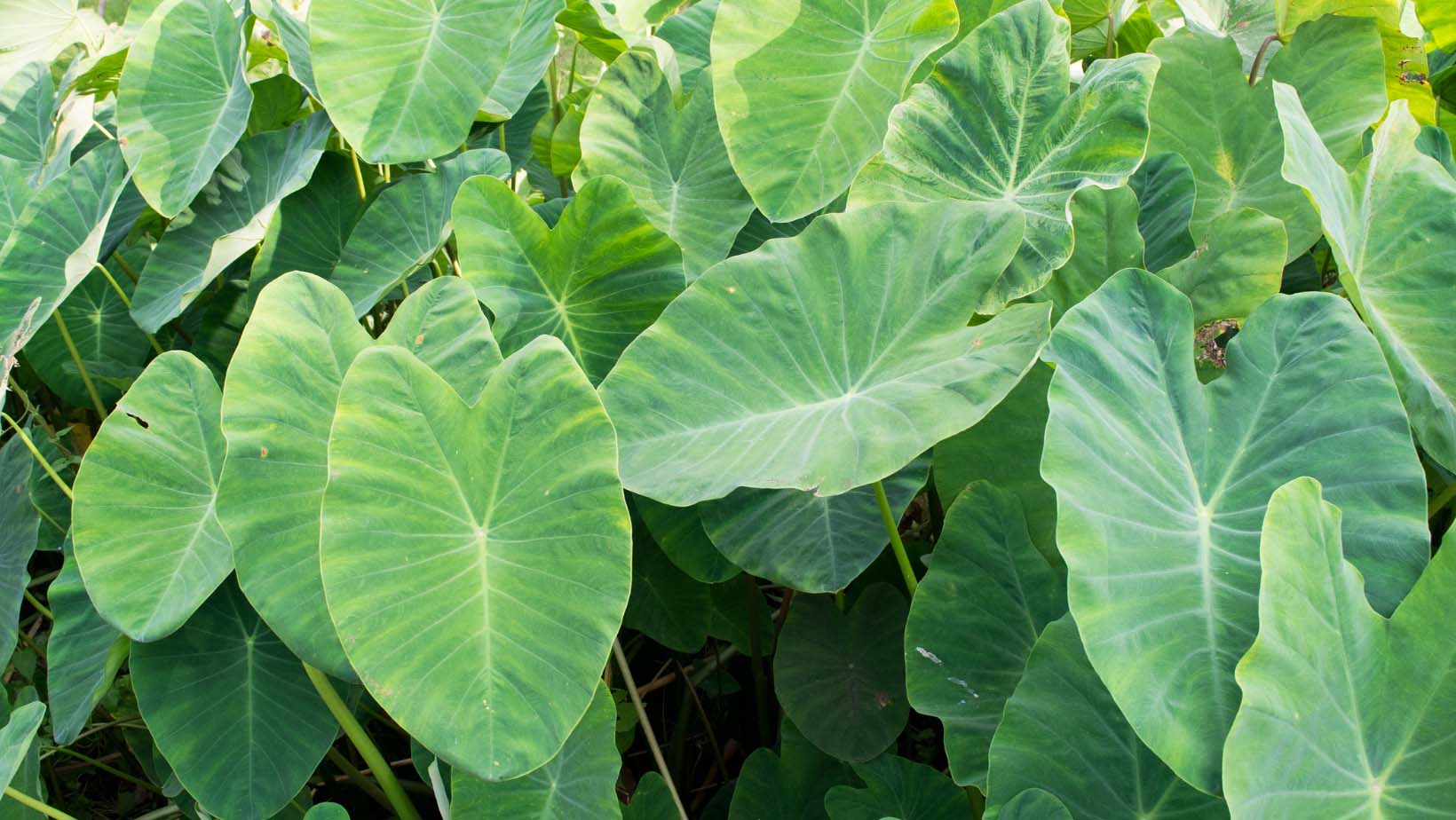Elephant Ears, known for their large, dramatic leaves, are a popular choice among gardeners looking to add a touch of the tropics to their landscapes. These plants, which belong to the genera Colocasia, Alocasia, and Xanthosoma, can transform any garden with their bold foliage and impressive size. Whether you’re a seasoned gardener or a beginner, growing Elephant Ears can be a rewarding experience. In this guide, we’ll take you through everything you need to know to successfully grow and care for these stunning plants.
Before you start growing Elephant Ears, it’s essential to understand the different varieties available. Each type has its own unique characteristics, growth habits, and care requirements.
Colocasia: Often referred to as “Taro,” Colocasia plants are known for their heart-shaped leaves that typically point downward. These plants thrive in wet conditions and are often grown in or near water gardens. They can grow up to 6 feet tall and are perfect for adding a lush, tropical feel to your garden.
Alocasia: Alocasia plants have striking arrow-shaped leaves that tend to point upward. They are typically smaller than Colocasia, but their unique leaf patterns, which can include striking veins and variegated colors, make them a standout in any garden. Alocasia varieties often prefer drier soil conditions and indirect sunlight.
Xanthosoma: This variety is less common but equally stunning. Xanthosoma plants feature large, arrowhead-shaped leaves and can grow to impressive heights. They are well-suited for tropical and subtropical climates and thrive in moist, well-drained soil.
Choosing the Right Location
Choosing the right location is crucial for the success of your Elephant Ears. These plants are relatively easy to grow, but they have specific needs regarding climate, sunlight, soil, and space.
Climate Considerations: Elephant Ears are tropical plants, so they thrive in warm, humid environments. They are best suited for USDA hardiness zones 8-11. If you live in a cooler climate, you can still grow Elephant Ears, but you’ll need to take special care to protect them during the winter months.
Sunlight Needs: The amount of sunlight your Elephant Ears need will depend on the variety. Colocasia varieties typically prefer full sun to partial shade, while Alocasia and Xanthosoma may do better in partial shade, especially in hotter climates. Too much direct sunlight can scorch their leaves, so finding the right balance is key.
Soil Requirements: Elephant Ears thrive in rich, well-drained soil. They prefer slightly acidic to neutral pH levels, ideally between 5.5 and 7.0. If your soil is too alkaline, consider amending it with organic matter such as compost or peat moss to lower the pH. Good drainage is also essential to prevent root rot, a common issue with these plants.
Space Requirements: These plants can grow quite large, so it’s important to give them enough space to spread out. Depending on the variety, you should space your plants 3 to 6 feet apart. This will allow the large leaves to fully develop without crowding neighboring plants.
Planting Elephant Ears
Once you’ve chosen the perfect location, it’s time to plant your Elephant Ears. Whether you’re planting from bulbs or transplants, proper preparation and planting techniques will set the stage for healthy growth.
When to Plant: The best time to plant Elephant Ears is in the spring, after the last frost has passed. These plants are sensitive to cold, so waiting until the soil has warmed up to at least 65°F (18°C) will give them the best start.
Preparing the Soil: Start by preparing the planting area. Work organic matter, such as compost or well-rotted manure, into the soil to enrich it and improve drainage. This will create a nutrient-rich environment that encourages strong root growth.
Planting Methods: If you’re planting from bulbs, dig holes that are 2 to 3 inches deep. Place the bulbs in the holes with the pointed end facing up, then cover them with soil. If you’re planting transplants, dig a hole that is slightly larger than the root ball, place the plant in the hole, and backfill with soil. Be sure to water the plants thoroughly after planting to help settle the soil around the roots.
Watering After Planting: Immediately after planting, give your Elephant Ears a deep watering. This helps to settle the soil and eliminate any air pockets around the roots. Keep the soil consistently moist as the plants establish themselves.
Caring for Elephant Ears
Caring for Elephant Ears involves regular watering, fertilizing, and maintenance to ensure they thrive throughout the growing season.
Watering Needs: Elephant Ears love water, so it’s important to keep the soil consistently moist, especially during hot, dry weather. However, avoid letting the soil become waterlogged, as this can lead to root rot. In particularly dry climates, consider setting up a drip irrigation system to provide consistent moisture.
Fertilizing: To support their rapid growth, Elephant Ears benefit from regular feeding. Use a balanced fertilizer, such as a 10-10-10 or 20-20-20 formula, every 4-6 weeks during the growing season. High nitrogen levels are especially important for promoting lush, green foliage.
Mulching: Apply a thick layer of mulch around the base of the plants to help retain moisture, regulate soil temperature, and suppress weeds. Organic mulch, such as shredded bark or leaf mold, works well and will gradually break down, adding nutrients to the soil.
Pruning and Maintenance: Regularly check your Elephant Ears for dead or yellowing leaves and remove them to keep the plant looking tidy and healthy. Pruning also helps to direct the plant’s energy toward new growth. Additionally, be mindful of the plant’s growth habits and adjust spacing if necessary to prevent overcrowding.
Managing Pests and Diseases
Like all plants, Elephant Ears can fall victim to pests and diseases. Early identification and treatment are crucial to maintaining healthy plants.
Common Pests: Watch for common pests such as aphids, spider mites, and caterpillars. These insects can damage the leaves and weaken the plant. Regularly inspect your plants and, if necessary, use insecticidal soap or neem oil to control infestations.
Disease Prevention: Elephant Ears are susceptible to fungal diseases like root rot and leaf spot, especially in humid conditions. To prevent these issues, ensure good air circulation around the plants, avoid overhead watering, and remove any affected leaves promptly.
Organic and Chemical Solutions: For those who prefer organic gardening methods, consider using companion planting, beneficial insects, and natural remedies to control pests and diseases. Chemical solutions, such as fungicides and insecticides, can be used as a last resort but should be applied carefully to avoid harming beneficial insects and the environment.
Overwintering Elephant Ears
If you live in a region with cold winters, you’ll need to take special care to overwinter your Elephant Ears.
Preparing for Winter in Cold Climates: In areas where temperatures drop below freezing, you’ll need to dig up the bulbs before the first frost. Carefully lift the bulbs from the ground, trim off the leaves, and allow them to dry in a cool, dry place for a few days. Once dry, store the bulbs in peat moss or sawdust in a cool, dark, frost-free area until spring.
Mulching for Protection: In milder climates, you can leave your Elephant Ears in the ground over winter. Apply a thick layer of mulch over the plants to protect them from frost. In spring, remove the mulch to allow new growth to emerge.
Container Growing: If your Elephant Ears are grown in containers, simply move the pots indoors to a cool, dark place during the winter months. Reduce watering and allow the plants to go dormant until the warmer weather returns.
Propagation of Elephant Ears
Propagating Elephant Ears is a great way to expand your garden or share these beautiful plants with others.
Division of Bulbs: The most common method of propagation is by dividing the bulbs. In the spring or fall, carefully dig up the bulbs and separate the offsets, or small bulbs that have formed around the main bulb. Replant the offsets in the garden or in containers.
Propagation by Offsets: Offsets can also be removed from the parent plant without digging up the entire bulb. Gently pull or cut the offset away from the main plant, ensuring it has some roots attached, and plant it in a new location.
Seed Propagation: While less common, Elephant Ears can be grown from seeds. Sow the seeds in a warm, humid environment and keep the soil moist. It may take several weeks for the seeds to germinate, and even longer for the plants to reach maturity.
Troubleshooting Common Issues
Even with the best care, you may encounter some issues while growing Elephant Ears. Here’s how to troubleshoot common problems:
Yellowing Leaves: Yellowing leaves can be a sign of overwatering, nutrient deficiencies, or pests. Check the soil moisture levels, adjust your watering routine, and ensure the plants are getting enough nutrients.
Slow Growth: If your Elephant Ears are growing slowly, they may not be receiving enough sunlight or nutrients. Make sure they are in a location with adequate light, and consider adding a balanced fertilizer to boost growth.
Leaf Browning or Curling: Environmental stressors such as too much sun, wind, or dry air can cause the leaves to brown or curl. Move the plants to a more sheltered location, increase humidity, or adjust your watering schedule to resolve these issues.
Creative Landscaping with Elephant Ears
Elephant Ears are versatile plants that can be used in various ways to enhance your garden’s design.
Designing with Elephant Ears: Use Elephant Ears as focal points in your garden, particularly in areas where their large leaves can create a dramatic effect. They work well in borders, around water features, or as a backdrop for smaller plants.
Companion Planting: Pair Elephant Ears with other tropical plants such as cannas, bananas, and gingers to create a lush, exotic garden. You can also combine them with flowering plants that thrive in similar conditions, such as begonias and impatiens.
Using Elephant Ears in Containers: If you have limited garden space or prefer a portable option, grow Elephant Ears in large containers. This allows you to move them around to create different looks throughout the season or bring them indoors during the winter.
Conclusion
Growing Elephant Ears can be a highly rewarding experience, bringing a touch of the tropics to your garden with their bold and dramatic foliage. By understanding the different varieties, choosing the right location, and providing proper care, you can enjoy these stunning plants for many years. Whether you’re creating a tropical oasis in your backyard or adding a few container plants to your patio, Elephant Ears are sure to impress with their size and beauty.


0 Comments